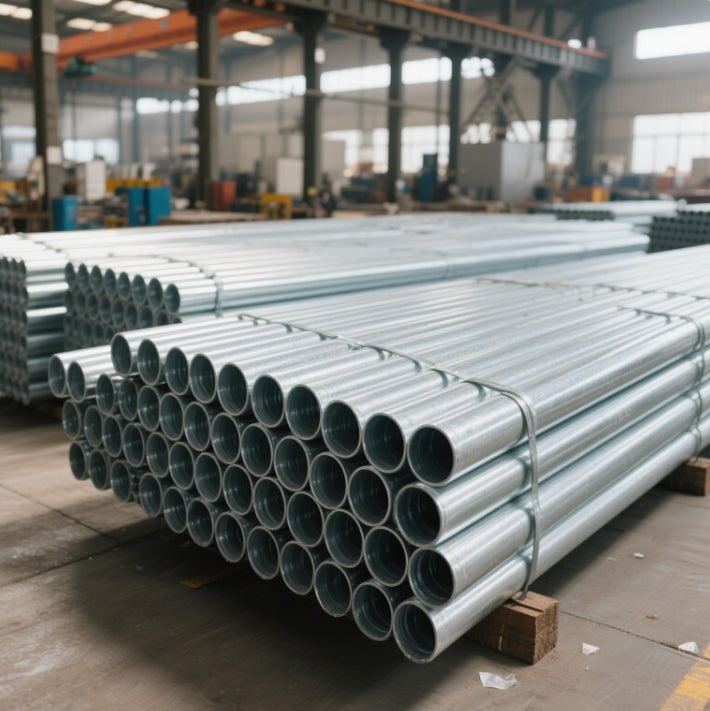StockSteel
Galvanized pipe Bulk Deals | Discounted Iron Tube Inventory
Galvanized pipe Bulk Deals | Discounted Iron Tube Inventory
Couldn't load pickup availability
Galvanized Pipe Bulk Deals | Discounted Iron Tube Inventory
Product Specifications
Comprehensive technical details for industrial buyers
| Parameter | Details |
|---|---|
| Diameter Range | 10x10mm – 1,000x1,000mm (Square/Rectangular) |
| Thickness | 0.3mm – 25mm (Customizable) |
| Material Grade | Q195, Q215, Q235, Q345 (Carbon Steel) |
| Surface Treatment | Hot-Dip Galvanized (Zinc Coating: 40–600g/m²) |
| Length | Standard: 5.8m, 6m, 12m |
| Hardness | 80–90 HRA (Vickers) |
Mechanical Properties
Tensile Strength
Galvanized pipes exhibit tensile strengths ranging from 315 MPa (Q195) to 630 MPa (Q345), ensuring structural integrity under high-pressure applications. For example, Q235-grade pipes achieve tensile strengths of 375–500 MPa, ideal for construction frameworks and fluid transport systems .
Bending Strength
The bending strength of galvanized pipes is approximately 60% of tensile strength, allowing flexibility in shaping without compromising durability. This property is critical for HVAC ducting, handrails, and agricultural equipment requiring precise bends .
Identification & Standards
Marking Methods
- ASTM A53/A106: Standard for seamless/welded galvanized steel pipes .
- EN 10255: European specifications for dimensional tolerances and zinc coating .
- JIS G3466: Japanese standards for structural applications .
- Grade Codes: Markings like "Q235" or "S355" are laser-etched for traceability .
Weight Calculation
Formula
Weight per meter (kg/m) = (Outer Diameter – Wall Thickness) × Wall Thickness × 0.02466
Example: For a 50mm OD pipe with 3mm thickness:
(50 – 3) × 3 × 0.02466 = 3.48 kg/m.
Custom Shapes
- Round Pipes: Use the standard formula above.
- Square/Rectangular Pipes: Weight = (4 × Wall Thickness × (Side Length – Wall Thickness)) × 0.00785.
Stainless Steel Corrosion: Causes & Prevention
Why Does Stainless Steel Rust?
- Surface Contamination: Oil, grease, or iron particles from tools can break the passive chromium oxide layer, leading to localized rust .
- Chloride Exposure: Saltwater or de-icing agents trigger pitting corrosion, especially in coastal or industrial environments .
- Mechanical Damage: Scratches or weld splatter disrupt the protective layer, exposing raw steel to oxidation .
- Improper Heat Treatment: Incorrect annealing or quenching reduces corrosion resistance .
Key Comparisons & Risks
copper vs galvanized pipe
- Durability: Galvanized pipes resist corrosion better than copper in alkaline environments but degrade faster in acidic conditions .
- Cost: Copper is 3–5× more expensive, making galvanized pipes economical for large-scale projects .
- Applications: Copper is preferred for drinking water due to antimicrobial properties, while galvanized suits industrial uses .
dangers of galvanized water pipes
- Zinc Leaching: Over time, zinc coatings corrode, releasing heavy metals into water, posing health risks .
- Lead Contamination: Older galvanized pipes may contain lead solder joints or traces from recycled materials, requiring testing .
- Reduced Flow: Internal rust buildup restricts water flow and increases pressure on pumps.
do galvanized pipes have lead in them
While modern galvanizing processes use lead-free zinc, pre-1980s pipes might contain lead residues from manufacturing or soldering. Regular water testing is advised for older installations.
Why Choose Our Stainless Steel Products?
- Superior Corrosion Resistance: Our stainless steel pipes (304/316L grades) withstand harsh chemicals and marine environments, outperforming galvanized pipes in longevity .
- Certified Quality: ISO 9001, CE, and SGS certifications ensure compliance with global standards .
- Custom Solutions: Tailored dimensions, surface finishes (mirror, brushed), and alloy compositions (duplex, superaustenitic) for specialized needs .
- Eco-Friendly: 100% recyclable with no toxic leaching, aligning with sustainable construction practices .
- Technical Support: Free consultation on material selection, welding techniques, and corrosion prevention .

